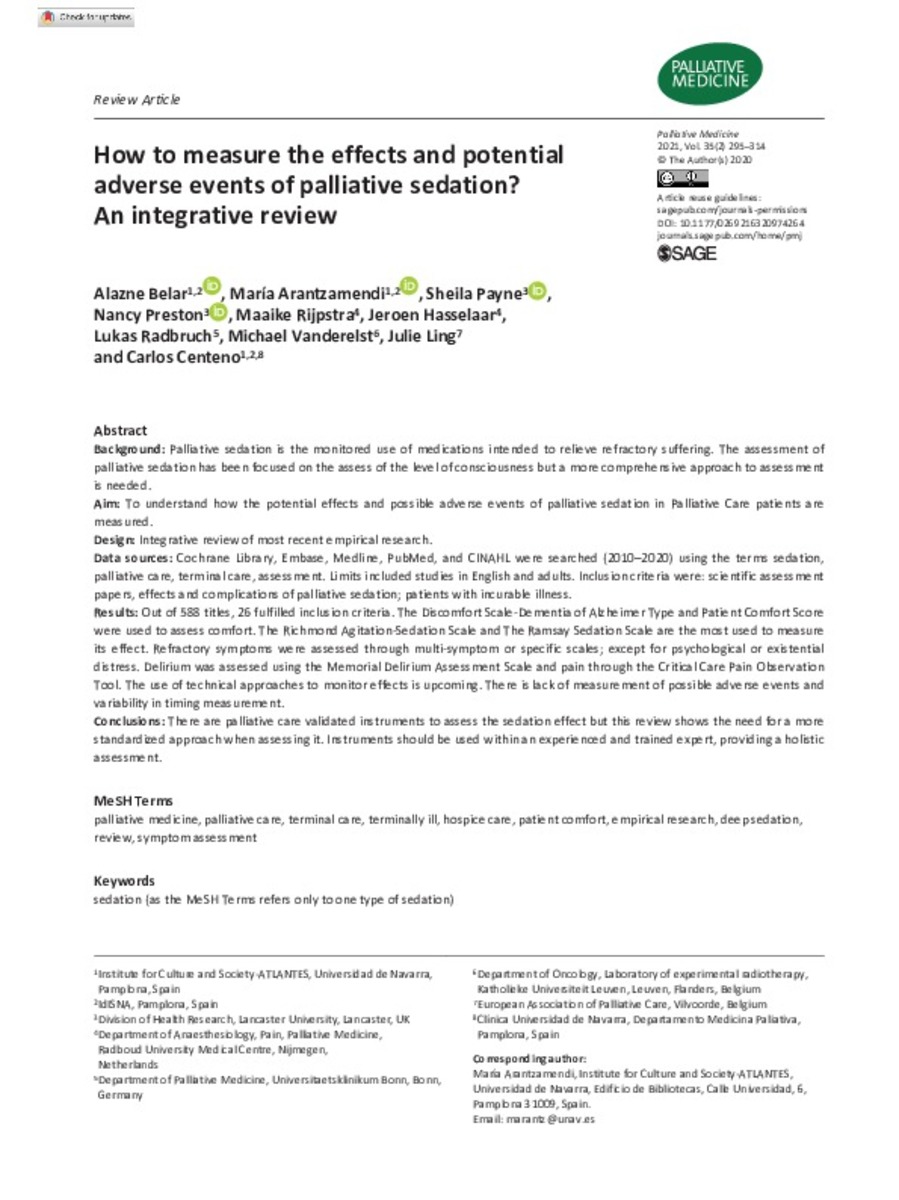Full metadata record
| DC Field | Value | Language |
|---|---|---|
| dc.creator | Belar, A. (Alazne) | - |
| dc.creator | Arantzamendi-Solabarrieta, M. (María) | - |
| dc.creator | Payne, S. (Sheila) | - |
| dc.creator | Preston, N. (Nancy) | - |
| dc.creator | Rijpstra, M. (Maaike) | - |
| dc.creator | Hasselaar, J. (Jeroen) | - |
| dc.creator | Radbruch, L. (Lukas) | - |
| dc.creator | Vanderelst, M. (Michael) | - |
| dc.creator | Ling, J. (Julie) | - |
| dc.creator | Centeno, C. (Carlos) | - |
| dc.date.accessioned | 2021-02-24T12:11:23Z | - |
| dc.date.available | 2021-02-24T12:11:23Z | - |
| dc.date.issued | 2021 | - |
| dc.identifier.citation | Belar A, Arantzamendi M, Payne S, Preston N, Rijpstra M., Hasselaar J, et al. How to mesure the effects and potential adverse events of palliative sedation? An integrative review. Palliat Med. 2021;35(2):295-314 | es_ES |
| dc.identifier.issn | 1477-030X | - |
| dc.identifier.uri | https://hdl.handle.net/10171/60120 | - |
| dc.description.abstract | Background: Palliative sedation is the monitored use of medications intended to relieve refractory suffering. The assessment of palliative sedation has been focused on the assess of the level of consciousness but a more comprehensive approach to assessment is needed. Aim: To understand how the potential effects and possible adverse events of palliative sedation in Palliative Care patients are measured. Design: Integrative review of most recent empirical research. Data sources: Cochrane Library, Embase, Medline, PubMed, and CINAHL were searched (2010–2020) using the terms sedation, palliative care, terminal care, assessment. Limits included studies in English and adults. Inclusion criteria were: scientific assessment papers, effects and complications of palliative sedation; patients with incurable illness. Results: Out of 588 titles, 26 fulfilled inclusion criteria. The Discomfort Scale-Dementia of Alzheimer Type and Patient Comfort Score were used to assess comfort. The Richmond Agitation-Sedation Scale and The Ramsay Sedation Scale are the most used to measure its effect. Refractory symptoms were assessed through multi-symptom or specific scales; except for psychological or existential distress. Delirium was assessed using the Memorial Delirium Assessment Scale and pain through the Critical Care Pain Observation Tool. The use of technical approaches to monitor effects is upcoming. There is lack of measurement of possible adverse events and variability in timing measurement. Conclusions: There are palliative care validated instruments to assess the sedation effect but this review shows the need for a more standardized approach when assessing it. Instruments should be used within an experienced and trained expert, providing a holistic assessment. | es_ES |
| dc.description.sponsorship | This work of ‘PalliativeSedation’ is funded by the Horizon 2020 Framework Programme of the European Union under Grant Agreement nº No. 825700. | es_ES |
| dc.language.iso | eng | es_ES |
| dc.publisher | SAGE | es_ES |
| dc.relation | info:eu-repo/grantAgreement/EC/H2020/825700/EU | es_ES |
| dc.rights | info:eu-repo/semantics/openAccess | es_ES |
| dc.subject | Palliative medicine | es_ES |
| dc.subject | Palliative care | es_ES |
| dc.subject | Terminal care | es_ES |
| dc.subject | Terminally ill | es_ES |
| dc.subject | Hospice care | es_ES |
| dc.subject | Patient comfort | es_ES |
| dc.subject | Empirical research | es_ES |
| dc.subject | Deep sedation | es_ES |
| dc.subject | Symptom assessment sedation | es_ES |
| dc.title | How to measure the effects and potential adverse events of palliative sedation? An integrative review | es_ES |
| dc.type | info:eu-repo/semantics/article | es_ES |
| dc.editorial.note | This article is distributed under the terms of the Creative Commons Attribution 4.0 License (https://creativecommons.org/licenses/by/4.0/) which permits any use, reproduction and distribution of the work without further permission provided the original work is attributed as specified on the SAGE and Open Access page (https://us.sagepub.com/en-us/nam/open-access-at-sage). | es_ES |
| dc.identifier.doi | 10.1177/0269216320974264 | - |
Files in This Item:
Statistics and impact
Items in Dadun are protected by copyright, with all rights reserved, unless otherwise indicated.






